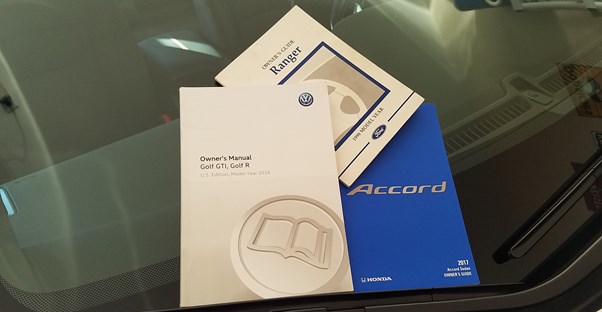Using Your Owner’s Manual

New cars today are way more complicated than cars even 10 years ago. When you purchased your car, you were probably in a rush. Maybe you had the seller show you how to Bluetooth your phone, but you probably didn’t go deeper than that. You thought you would read the owner’s manual latter, but you never did – that thing looks thicker than War and Peace. Now you are on the side of some deserted road in the rain and mud, trying to find jack instructions in your owner’s manual under a dim dome light.
You don’t have to read your manual cover to cover. In fact, that’s probably a terrible idea. But you should definitely go through a handful of highlights, so that you’re prepared when something goes wrong with your car. Here are some things in your manual you might want to look up. Consider adding tabs to the pages, or making a list in the front of the manual with the sections you need and the page numbers they started on. Finally, make some time to find these things on your car in the comfort of your garage or driveway.
Jack/Spare Tire
Most cars today have a space saver tire under the floor of the hatch or trunk. This tire is not meant to be a permanent replacement for a flat. It’s just to get you to a tire repair location. Located near the spare tire, you’ll usually find equipment to change your tire – a jack and a tire iron to take off the lug nuts. Sometimes the tire iron is also used to raise the jack. Your car has specific points to place the jack under the car. If you put the jack in the wrong position, it can go through your car like a can opener.
Locate your spare, jack and tire iron. Then kneel down and locate the jack location point shown in your manual. If you are really on your game, you might want to do a dry run and try out the jack. You could even make a small mark with a permanent marker on the car’s frame to remind you of where the jack goes. Tab the jack instructions, so you can find them later.
TPMS
Newer cars have a Tire Pressure Monitor System (TPMS). If one of your tires has air pressure significantly lower than the other tires, a tire icon will light on your dash. Once you have patched the tire or filled that low tire up with air, you may have to resync the TPMS. The instructions for that should be tabbed.
Fuse Box
Your car will have two fuse boxes, one you probably don’t want to mess with in the engine compartment and one that controls almost all of your accessories in the passenger compartment. If you’re lucky, then when something fails in the car like your headlights or wipers, it’s simply a burned fuse. Locate your dash fuse box in the manual and then on the car, and pull open the fuse door. Some cars have spare fuses of each amperage in the box and a fuse puller clamp to grab them with.
What each fuse does will be listed in your manual and sometimes on the back of the fuse door. The amperage number will be on the fuse itself: 5,10,20, etc. Tab this page in your manual and, if your car does not carry spare fuses, get on up to your local auto parts store and buy a set of spare fuses to leave in your glove box. They’re not expensive, and you never know when you might need them. Pulling a fuse and replacing it is easy if you know the right one to pull and you have a spare handy. Use the clamp or your finger tips to pull the bad fuse and simply push the replacement of the same amperage into the same place.
Oil Type/Grade
Your car has a specific recommended oil grade to use. It will be something like 10W30 or 0W20. Also, your car may require synthetic oil rather than conventional. You will need this information if your oil is low and you need to add some, or if you use a local quick lube place to change your oil rather than the dealer. The lube joint will ask you what type and grade of oil you want. Tab or add this oil information to your list.
Dipstick Locations
Your car probably has three dipsticks to check fluid levels. You should check your oil dipstick frequently, especially if your car burns oil. Running your vehicle with low oil can ruin the engine. Your car will have a power steering dipstick and, if your car has an automatic transmission, it will have a transmission dipstick. (These use hydraulic power steering and transmission fluids, not oil.) These require much less frequent checking than your engine oil, but you should still know where they are. Find the part of the manual that tells you how to locate your dipsticks in the engine compartment, and tab it.
Coolant Level
Your car needs a radiator to cool the engine. That radiator is filled with a 50/50 mix of coolant and water. A rubber tube from your radiator goes to a plastic overflow container. On this container will be a max and minimum level. Your coolant level should be in between these marks. There’s no need to take off the radiator cap to check your coolant level. If you need to add coolant, you can add it to the overflow container rather than directly into the radiator. Locate the coolant level inspection instructions in your owner’s manual and tab that or add the page number to your VIP list.
(Photo credit Phil Basinger)

